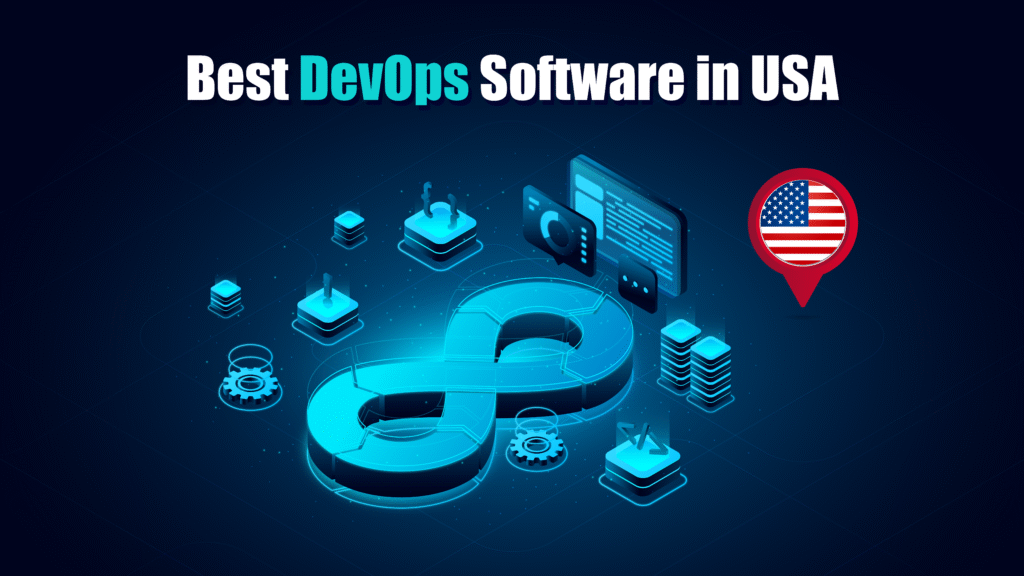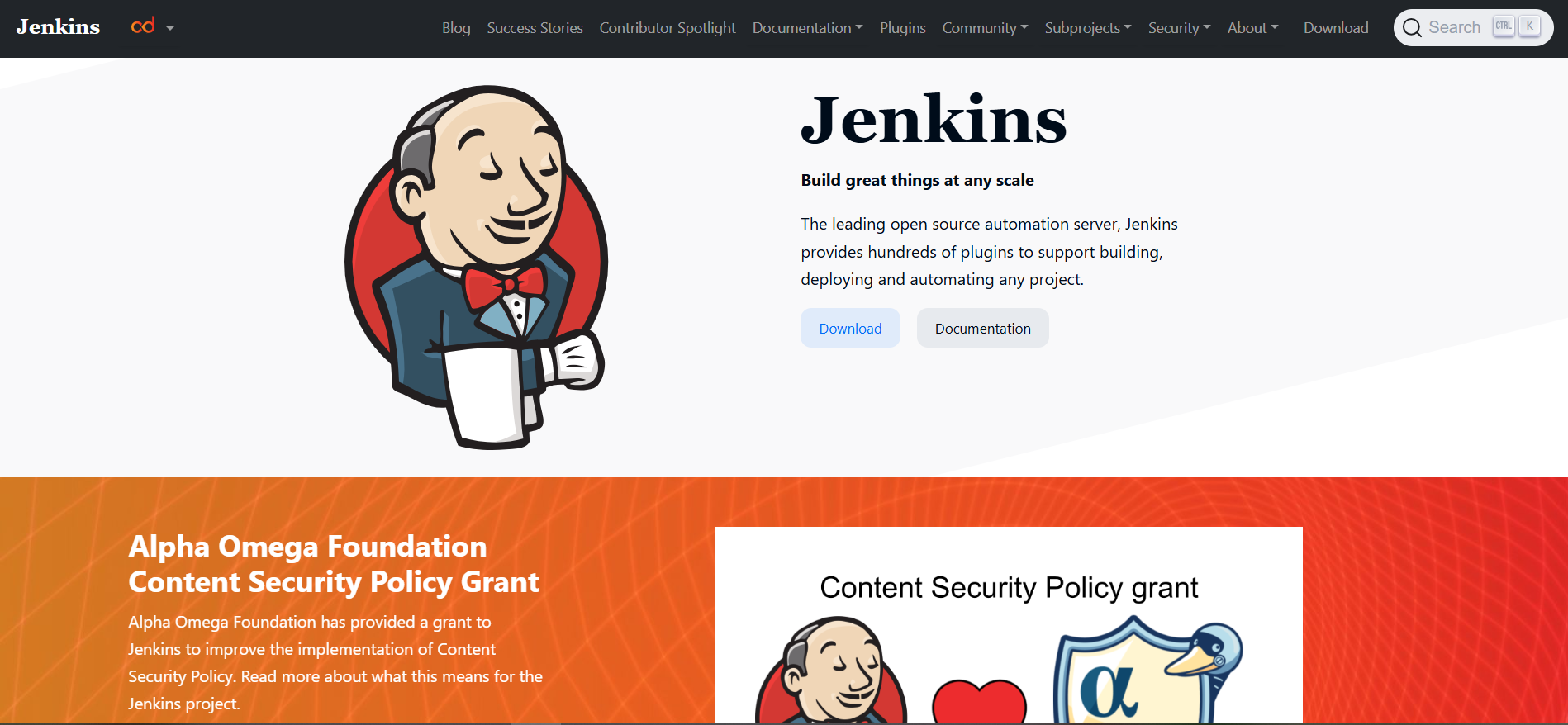Choosing the right DevOps software in USA can be a daunting task for organizations that want to streamline their software development and operations processes. With numerous tools available, understanding the best fit for your needs is crucial. What features should you prioritize best DevOps Software in USA? What makes one tool better than the other? Which DevOps platforms are trusted by the top companies in the USA?
This guide presents a detailed comparison of the top 15 DevOps Software for 2025. After extensive research, we’ve reviewed the tools based on their usability, scalability, integrations, pricing models, and real user feedback. Whether you are a startup, a mid-sized company, or an enterprise-level organization, this article will help you select the best DevOps tool to suit your needs.
Overview of the Top 15 DevOps Software in USA in 2025:
Here’s a quick summary of the top DevOps software picks for 2025:
- Jenkins – Best for Continuous Integration and Continuous Delivery
- Ansible – Best for IT Automation
- Docker – Best for Containerization
- Kubernetes – Best for Container Orchestration
- Prometheus – Best for Monitoring and Alerting
- Chef – Best for Infrastructure as Code (IaC)
- Git – Best for Version Control
- Puppet – Best for Automation of Infrastructure
- Terraform – Best for Infrastructure as Code
- GitHub Actions – Best for Continuous Integration in GitHub Repositories
- GitLab – Best for Integrated DevOps Platform
- Bitbucket – Best for Git Repositories and CI/CD
- CircleCI – Best for Fast and Reliable CI/CD
- Azure DevOps Server – Best for Enterprise-Level DevOps
- Bamboo – Best for CI/CD and Release Management
How This Top 15 List Was Created
Our team evaluated DevOps Software based on:
- Pricing Models: We considered per-user charges, usage-based pricing, and tiered plans for different business sizes.
- Features and Functionality: We focused on CI/CD, container orchestration, version control, infrastructure automation, and monitoring.
- Scalability: We prioritized tools that scale from startups to enterprises.
- Compliance and Security: We ensured the software adheres to industry standards like GDPR and SOC 2.
- User Feedback: We analyzed real reviews on ease of use, customer service, and reliability.
- Integration: We checked if the tools integrate with popular platforms like Git, Jira, Docker, and Kubernetes.
Pricing Comparison for Small Teams and Startups
For startups, free or low-cost solutions are key. Tools like Jenkins, Docker, and GitHub Actions offer essential features with minimal costs.
Example Pricing:
- Jenkins: Free
- GitHub Actions: Free for public repos, paid for private repos
- Docker: Free (basic), additional costs for enterprise versions
Pricing for Growing SMEs and Enterprises
For growing businesses, platforms like GitLab, CircleCI, and Ansible provide scalable pricing starting at $5–$15 per user/month.
Example Pricing:
- GitLab: Starts at $19/user/month
- CircleCI: Free tier, paid plans from $15/user/month
- Ansible: Free (Community), enterprise plans start at $10,000/year
Pricing for Enterprise-Level Solutions
For enterprises, Azure DevOps Server, Terraform, and Kubernetes offer advanced features with higher pricing for global operations.
Example Pricing:
- Azure DevOps Server: Starts at $6/user/month
- Terraform: Free (open-source), enterprise plans from $20/user/month
- Kubernetes: Free (open-source), managed services priced based on usage (e.g., GKE, EKS, AKS)
#1. Jenkins – Best for Continuous Integration and Continuous Delivery
Jenkins is the most popular open-source automation tool for continuous integration (CI) and continuous delivery (CD). It helps automate building, testing, and deploying code, making it an essential DevOps Software for teams adopting DevOps principles.
Features:
-
Automates build and deployment: Jenkins automates the entire process of building, testing, and deploying applications, making the CI/CD pipeline more efficient.
-
Extensive Plugin Ecosystem: Over 1,000 plugins are available to integrate Jenkins with other tools, making it highly customizable.
-
Cross-platform support: Jenkins runs on Windows, Linux, and macOS, providing flexibility for development teams working across various platforms.
-
Pipeline as Code: Jenkins allows you to define your build and deployment processes as code, making the process repeatable and transparent.
Reviews:
Users love Jenkins for its extensibility and flexibility in managing complex CI/CD pipelines. However, its setup can be complicated for beginners, and users sometimes report challenges with scaling Jenkins for large teams or projects.
Final Verdict:
Jenkins is a powerful DevOps tool suitable for teams that need flexibility and control over their CI/CD pipelines. While it may require some effort to set up, its wide range of plugins and open-source nature make it a highly popular choice among developers.
Pros:
- Open-source and free
- Highly customizable with plugins
- Supports a wide variety of integrations
- Active community and vast documentation
Cons:
- Complex setup, especially for beginners
- Can become resource-intensive for large teams
- Maintenance and configuration require expertise
#2. Ansible – Best for IT Automation
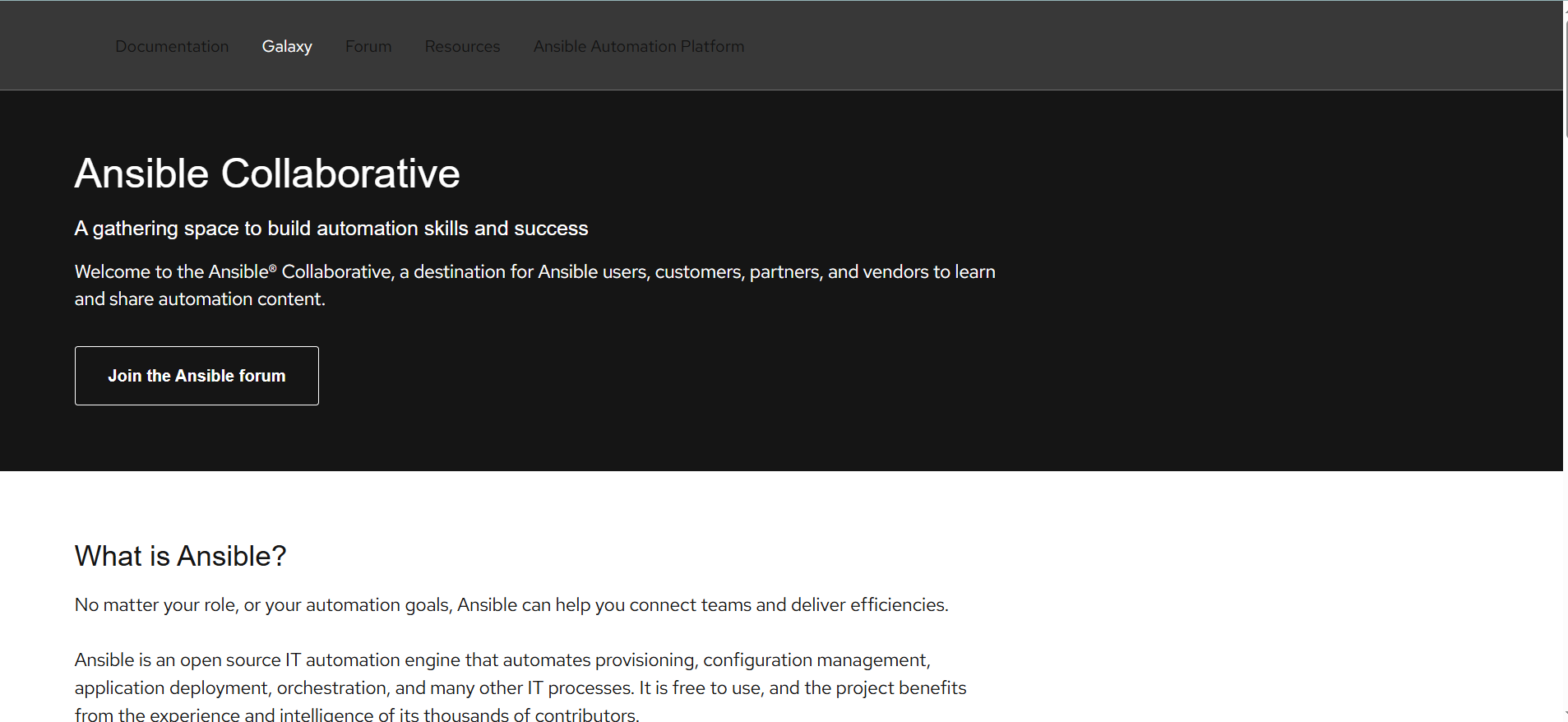 Ansible is an open-source DevOps Software for automating configuration management, application deployment, and IT infrastructure tasks. It enables teams to automate their IT workflows without needing agents on remote systems, making it one of the easiest tools to implement.
Ansible is an open-source DevOps Software for automating configuration management, application deployment, and IT infrastructure tasks. It enables teams to automate their IT workflows without needing agents on remote systems, making it one of the easiest tools to implement.
Features:
-
Agentless architecture: Ansible doesn’t require agents to be installed on nodes, which simplifies the setup and management of automation tasks.
-
Declarative language (YAML): Ansible uses YAML, a simple human-readable language for writing automation scripts.
-
Scalable: Ansible can automate tasks for thousands of nodes with minimal overhead.
-
Cloud Support: It supports cloud automation with various platforms, including AWS, Google Cloud, and Microsoft Azure.
Reviews:
Ansible is praised for its simplicity, scalability, and ease of use. Many users find it easier to integrate into existing infrastructure than other configuration management tools. However, it can become less efficient as the size of the infrastructure grows.
Final Verdict:
Ansible is an excellent choice for organizations looking to automate IT tasks, whether in development, testing, or production environments. It’s especially useful for teams seeking simplicity and ease of use in their automation workflows.
Pros:
- Simple and easy to use with no agents required
- YAML-based scripts are easy to read and understand
- Highly scalable for automation tasks
- Great community support
Cons:
- May face scaling challenges for very large environments
- Limited native support for Windows-based systems
- Some advanced features are behind paywalls
#3. Docker – Best for Containerization
 Docker is a containerization platform that enables developers to package applications and their dependencies into standardized units called containers. Docker ensures that applications run consistently across different environments, reducing compatibility issues and speeding up deployment.
Docker is a containerization platform that enables developers to package applications and their dependencies into standardized units called containers. Docker ensures that applications run consistently across different environments, reducing compatibility issues and speeding up deployment.
Features:
-
Easy containerization: Docker allows developers to easily containerize applications, ensuring they work the same in development, testing, and production environments.
-
Docker Hub: A repository for sharing Docker images, making it easier to download and use pre-built images for applications.
-
Integration with Kubernetes: Docker works seamlessly with Kubernetes, a container orchestration tool, to help manage large-scale containerized applications.
-
Isolation: Containers ensure that applications run in isolated environments, preventing conflicts between dependencies.
Reviews:
Docker is widely recognized for simplifying deployment and eliminating the need for complex virtual machines. Users appreciate its ease of use and integration with cloud platforms. Some users, however, have noted that Docker containers can be resource-intensive when managing large-scale applications.
Final Verdict:
Docker is an indispensable DevOps Software for teams adopting a containerized approach to software development. Its ability to provide consistent environments across platforms makes it a must-have DevOps Software for team focused on streamlining deployment processes.
Pros:
- Simplifies application deployment and scaling
- Ensures consistent development, testing, and production environments
- Strong ecosystem and community support
Cons:
- Can be resource-intensive when managing large-scale applications
- Requires careful management of complex multi-container applications
- Learning curve for new users
#4. Kubernetes – Best for Container Orchestration
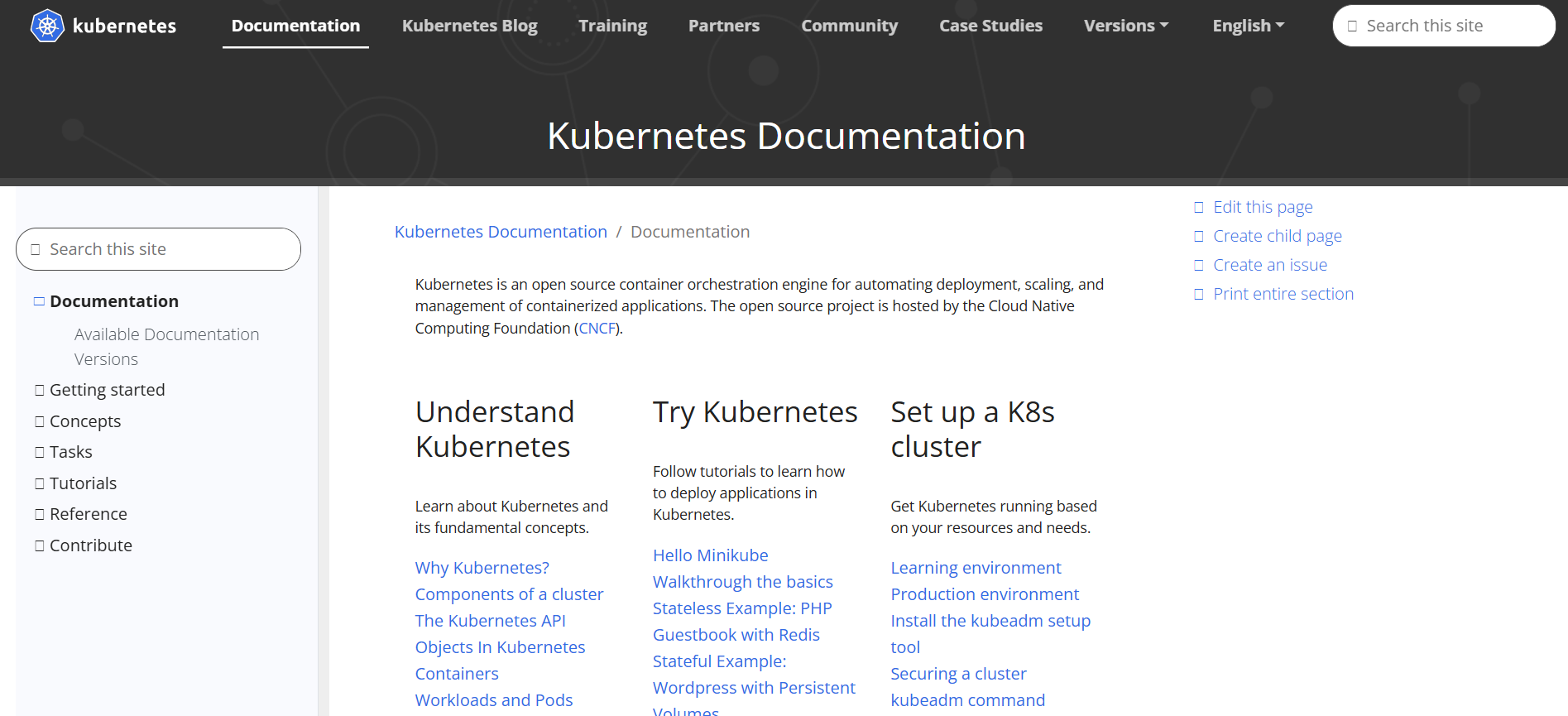 Kubernetes is an open-source platform designed to automate the deployment, scaling, and management of containerized applications. It is commonly used alongside Docker to manage large clusters of containers, ensuring applications are always available and responsive.
Kubernetes is an open-source platform designed to automate the deployment, scaling, and management of containerized applications. It is commonly used alongside Docker to manage large clusters of containers, ensuring applications are always available and responsive.
Features:
-
Automated scaling: Kubernetes can automatically scale containerized applications based on load, ensuring optimal resource allocation.
-
Self-healing: Kubernetes monitors the health of containers and automatically replaces failed ones, ensuring high availability.
-
Multi-cloud support: Kubernetes can run on various cloud platforms, making it highly flexible for hybrid cloud setups.
-
Load balancing: Kubernetes offers built-in load balancing to distribute traffic efficiently across containers.
Reviews:
Kubernetes is highly praised for its scalability and robustness in managing containerized applications. It is essential for managing microservices-based architectures. However, it requires considerable expertise to configure and manage properly.
Final Verdict:
Kubernetes is ideal for teams managing large, complex applications at scale. Its self-healing and automatic scaling features make it indispensable for organizations running microservices or containerized applications.
Pros:
- Excellent scalability and automation
- Self-healing capabilities ensure reliability
- Strong support for hybrid and multi-cloud environments
Cons:
- Steep learning curve and complex setup
- Requires significant resources and expertise
- Maintenance can be challenging
#5. Prometheus – Best for Monitoring and Alerting
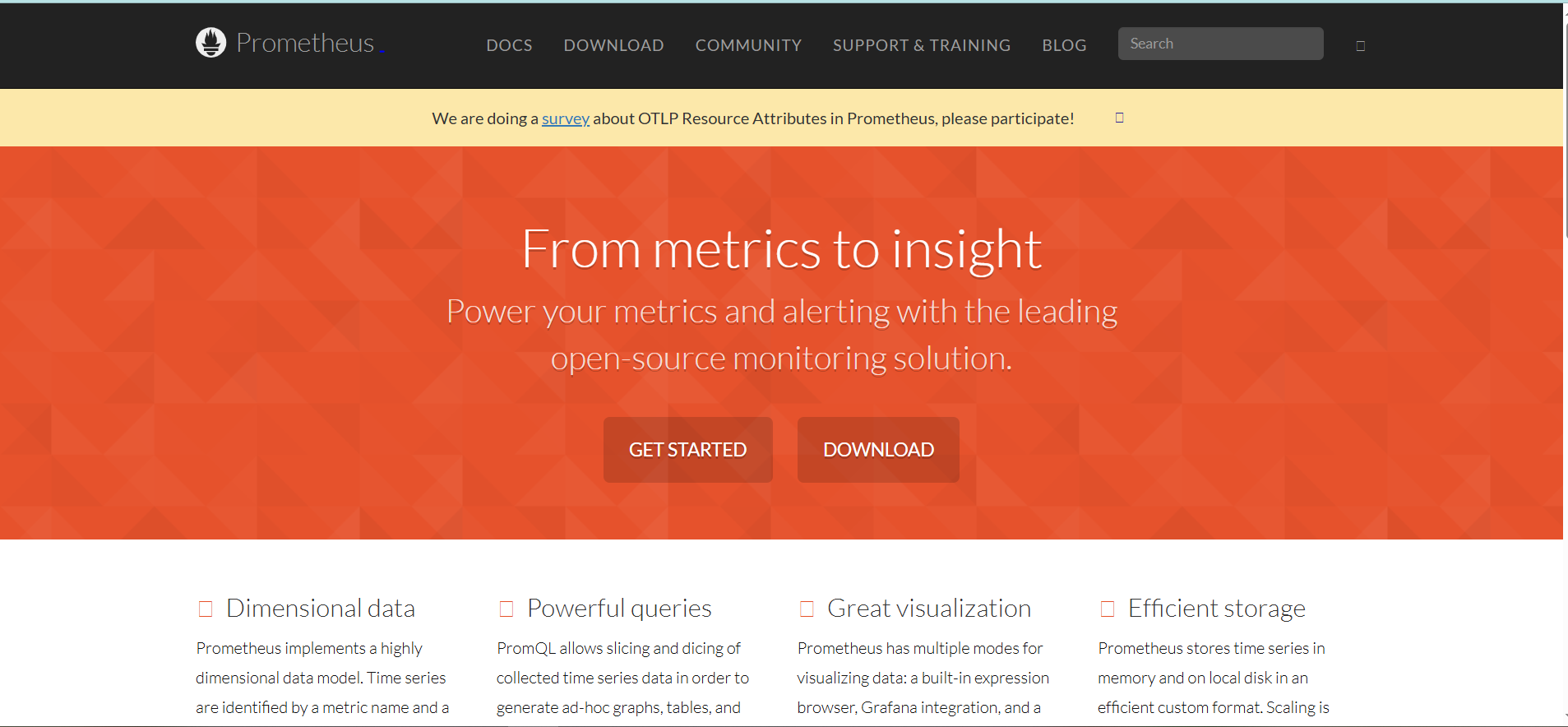 Prometheus is an open-source monitoring and alerting DevOps Software designed for reliability and scalability in dynamic environments. It is widely used for monitoring applications and infrastructure in real-time and for setting up alerting rules based on metrics.
Prometheus is an open-source monitoring and alerting DevOps Software designed for reliability and scalability in dynamic environments. It is widely used for monitoring applications and infrastructure in real-time and for setting up alerting rules based on metrics.
Features:
-
Time-series data collection: Prometheus collects time-series data, which helps track metrics over time and provides insights into system performance.
-
Query language (PromQL): Prometheus uses a powerful query language called PromQL, allowing users to analyze and retrieve data easily.
-
Alert manager: Prometheus comes with an integrated alert manager that helps teams set up and manage alerts for performance issues or failures.
-
Integrates with Kubernetes: Prometheus works well with Kubernetes, making it ideal for monitoring containerized applications.
Reviews:
Prometheus is loved for its scalability, flexibility, and deep integration with Kubernetes. It’s highly effective at gathering and analyzing metrics, although some users report that setting up alerting and visualization can be complex.
Final Verdict:
Prometheus is an excellent choice for teams needing robust monitoring and alerting capabilities in cloud-native and containerized environments. Its powerful query language and integration with Kubernetes make it ideal for modern, dynamic applications.
Pros:
- Powerful query language (PromQL)
- Deep integration with Kubernetes
- Highly scalable for large environments
Cons:
- Complex setup and configuration
- Visualization setup requires integration with Grafana or other tools
- Alerting and notification configuration can be challenging
#6. Chef – Best for Infrastructure as Code (IaC)
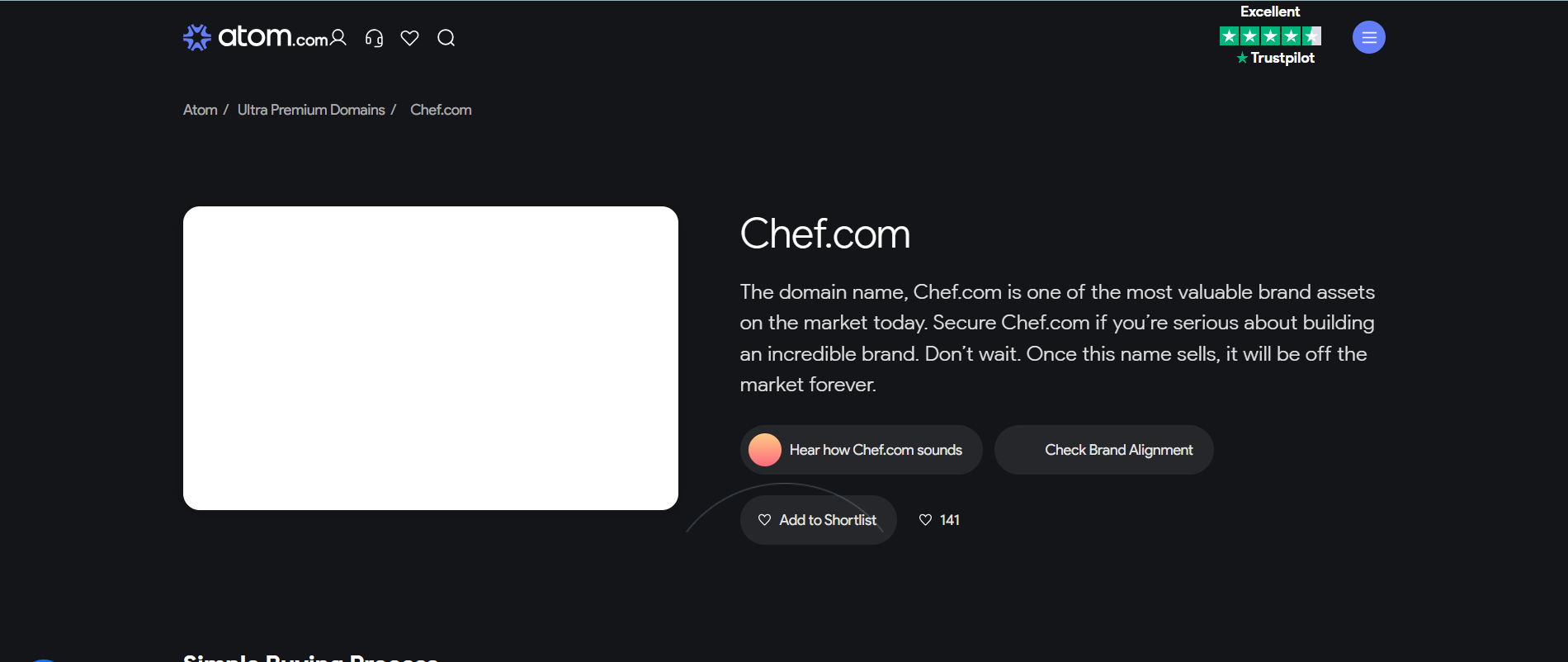 Chef is an open-source configuration management DevOps Software that enables teams to automate infrastructure deployment and management. It uses Ruby-based DSL (Domain Specific Language) for writing scripts that define infrastructure resources.
Chef is an open-source configuration management DevOps Software that enables teams to automate infrastructure deployment and management. It uses Ruby-based DSL (Domain Specific Language) for writing scripts that define infrastructure resources.
Features:
-
Automates infrastructure management: Chef automates the configuration and management of servers and infrastructure resources.
-
Test-driven infrastructure management: Chef’s infrastructure is tested automatically before it is deployed, ensuring consistency.
-
Multi-cloud support: Chef works across various cloud environments, including AWS, Azure, and Google Cloud.
-
Customizable configurations: Chef enables users to create and manage custom configurations for servers and applications.
Reviews:
Chef is widely praised for its flexibility and scalability, especially in large environments. Users appreciate its ability to manage both on-premise and cloud infrastructure. Some users find the Ruby-based DSL difficult to learn.
Final Verdict:
Chef is an ideal choice for enterprises with complex infrastructure management needs. Its IaC capabilities and robust testing features make it a top choice for managing large-scale environments efficiently.
Pros:
- Strong community and ecosystem
- Highly customizable configurations
- Supports multi-cloud environments
Cons:
- Learning curve for those unfamiliar with Ruby-based DSL
- Setup and maintenance can be complex
- Documentation could be more beginner-friendly
7. Git – Best for Version Control

Git is a distributed version control system (VCS) that tracks changes to files and helps developers collaborate on code. It is essential for managing source code history and supporting parallel development.
Features:
-
Distributed architecture: Each developer has a complete local copy of the project repository, making it ideal for collaboration.
-
Branching and merging: Git allows developers to create branches to work on features independently and merge them back later.
-
Security and integrity: Git ensures the integrity of your code by hashing every change made to the repository.
-
Popular integrations: Git integrates with various DevOps tools like Jenkins, GitLab, and GitHub.
Reviews:
Git is a favorite among developers for its speed, flexibility, and collaborative capabilities. It’s a fundamental tool for DevOps teams and software developers worldwide. Beginners, however, may struggle with the initial learning curve related to commands and workflows.
Final Verdict:
Git is indispensable for managing codebases and version control. If your team is not already using Git, it is essential for efficient collaboration and version management in a DevOps pipeline.
Pros:
- Distributed architecture ensures collaboration efficiency
- Flexible branching and merging
- Strong security and data integrity
Cons:
- Steep learning curve for beginners
- Requires proper branch management to avoid conflicts
- Can be complex for large teams if not used properly
#8. Puppet – Best for Automation of Infrastructure
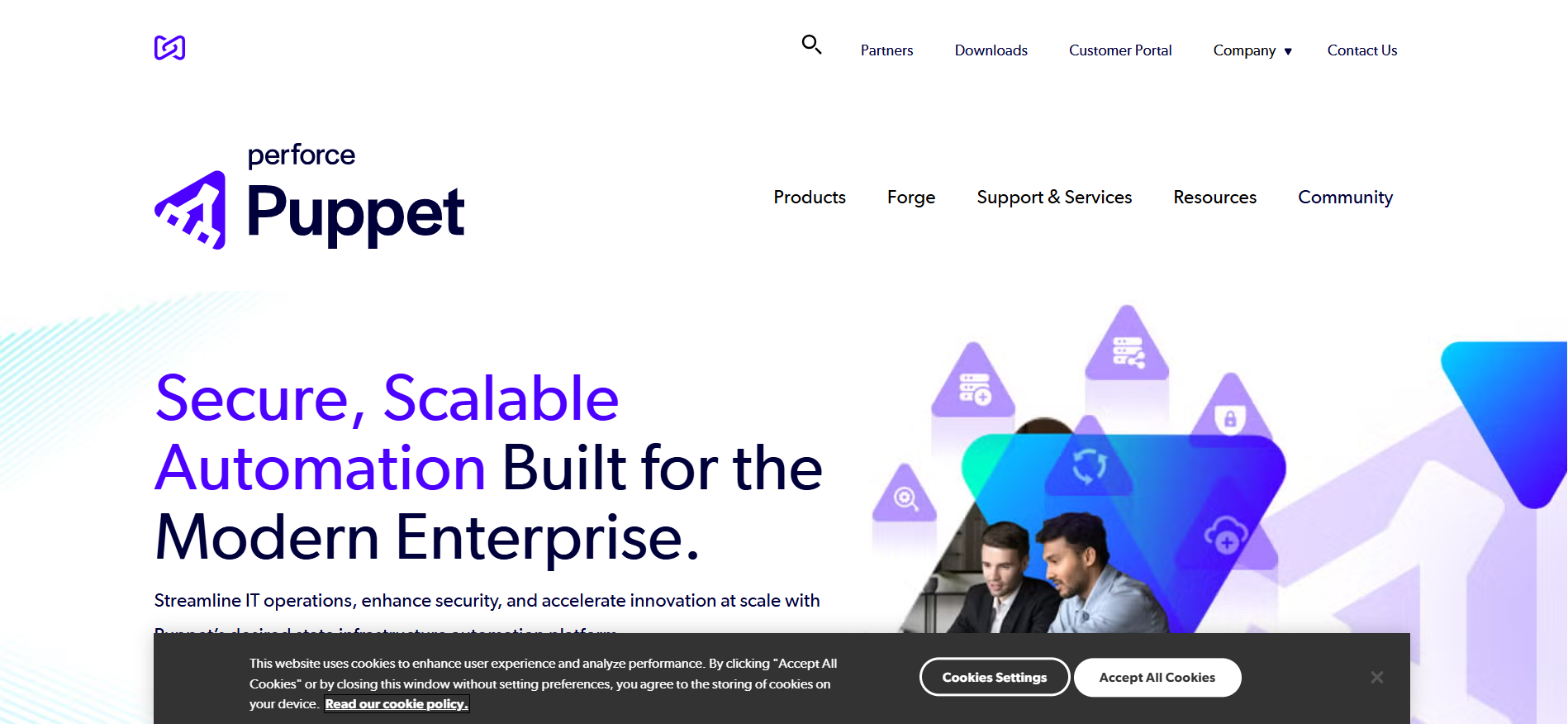 Puppet is an open-source automation DevOps Software designed to manage infrastructure throughout its lifecycle. Puppet allows DevOps teams to define their infrastructure as code, ensuring that systems are deployed and configured consistently and automatically.
Puppet is an open-source automation DevOps Software designed to manage infrastructure throughout its lifecycle. Puppet allows DevOps teams to define their infrastructure as code, ensuring that systems are deployed and configured consistently and automatically.
Features:
-
Automated infrastructure management: Puppet automates the entire infrastructure lifecycle, including provisioning, configuration, and deployment.
-
Model-driven approach: Puppet uses a declarative language to define infrastructure, making it easy to understand and manage.
-
Large ecosystem of modules: Puppet has a wide range of pre-built modules available for different operating systems and applications, reducing the need for custom code.
-
Cross-platform support: Puppet supports a wide range of operating systems and platforms, including Linux, Windows, and macOS.
Reviews:
Puppet is often praised for its scalability and ability to manage large infrastructures. Many users appreciate its rich ecosystem of modules that simplify automation tasks. Some users, however, feel that its complexity and learning curve can be daunting for beginners.
Final Verdict:
Puppet is an excellent choice for enterprises that need to automate and manage large-scale infrastructure. It’s particularly effective for teams with complex infrastructure requirements that need fine-grained control over configuration.
Pros:
- Mature and well-established tool
- Extensive ecosystem of pre-built modules
- Cross-platform support
Cons:
- High learning curve, especially for beginners
- Configuration syntax can be challenging
- Requires more resources compared to simpler tools
#9. Terraform – Best for Infrastructure as Code (IaC)
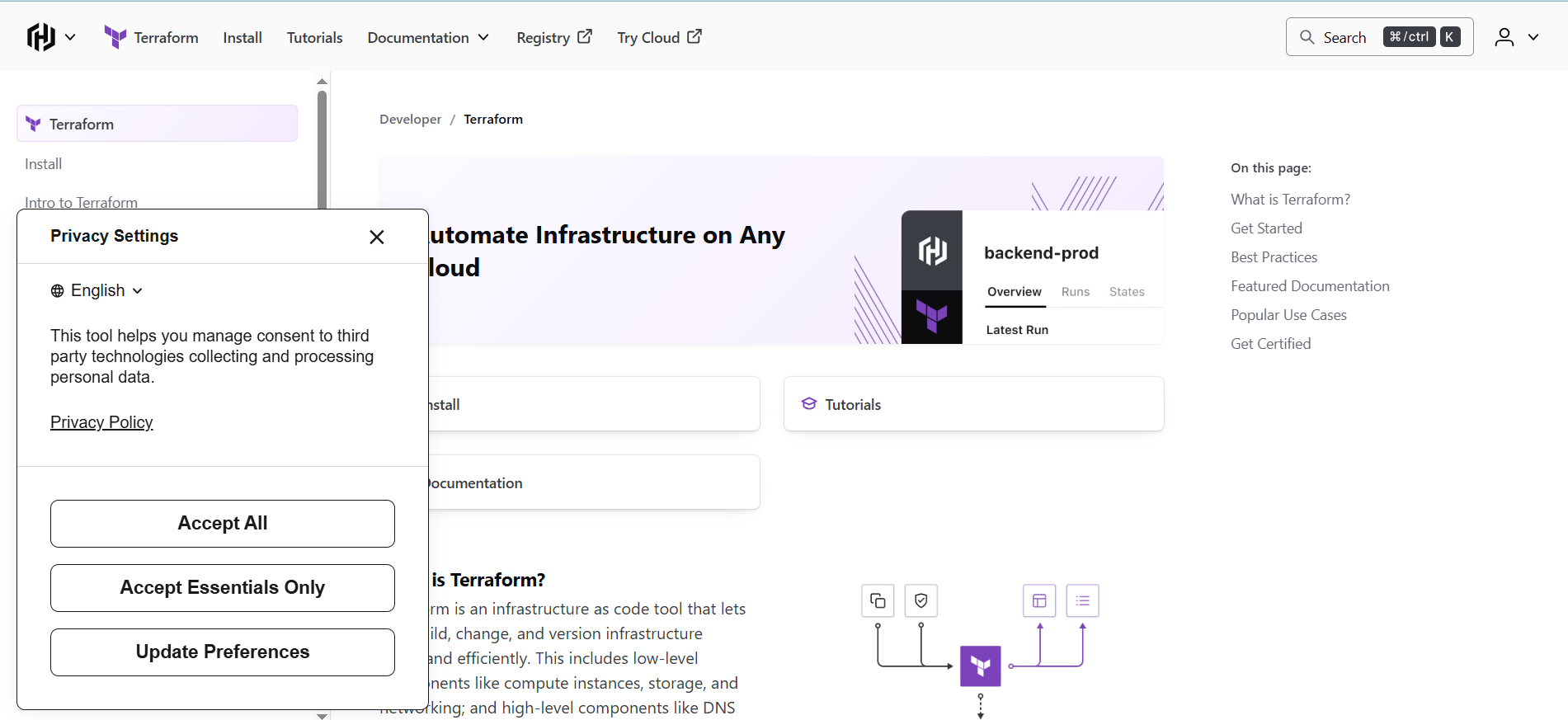 Terraform is an open-source DevOps Software that enables teams to define both cloud and on-premise infrastructure as code. It allows developers to manage and provision infrastructure resources using a declarative configuration language.
Terraform is an open-source DevOps Software that enables teams to define both cloud and on-premise infrastructure as code. It allows developers to manage and provision infrastructure resources using a declarative configuration language.
Features:
-
Declarative IaC: Terraform uses HCL (HashiCorp Configuration Language) to define infrastructure in a human-readable format.
-
Multi-cloud support: Terraform supports provisioning resources across various cloud platforms, including AWS, Azure, Google Cloud, and more.
-
State management: Terraform automatically manages infrastructure state and tracks changes to ensure resources are created, modified, or destroyed appropriately.
-
Extensive provider support: Terraform has a vast library of providers, making it easy to manage both cloud and non-cloud infrastructure resources.
Reviews:
Terraform is highly regarded for its simplicity and power in managing infrastructure. Users appreciate its ability to work across multiple cloud environments, making it a great choice for hybrid cloud strategies. However, beginners may find it challenging to manage state files and deal with complex configurations.
Final Verdict:
Terraform is ideal for teams adopting Infrastructure as Code (IaC) and looking to automate resource management in multi-cloud environments. Its flexibility and wide support for providers make it a standout tool for cloud-native infrastructure management.
Pros:
- Easy-to-read declarative configuration language (HCL)
- Multi-cloud support and flexibility
- Strong community and provider support
Cons:
- Managing state files can be complex
- Configuration syntax may take time to learn
- Not as suitable for managing applications directly
#10. GitHub Actions – Best for Continuous Integration in GitHub Repositories
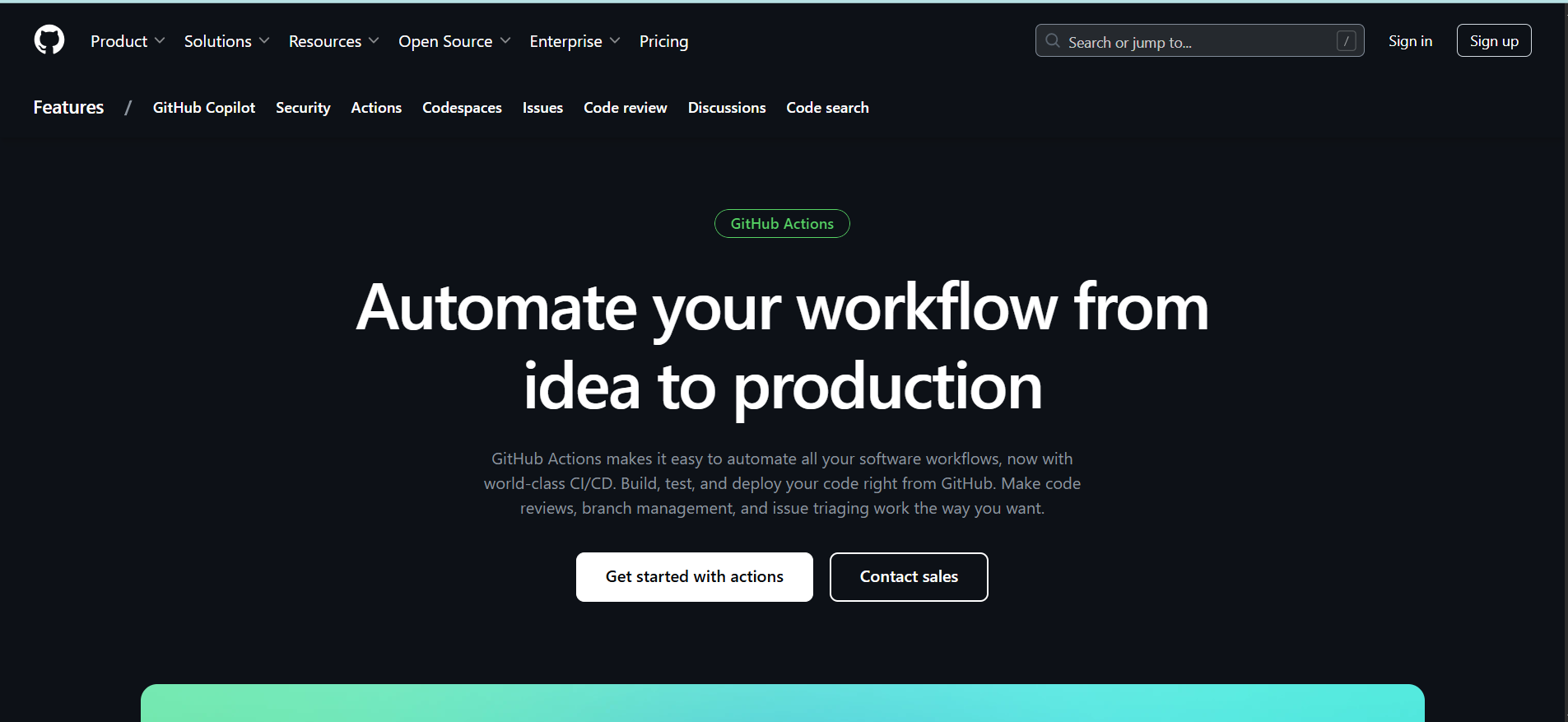 GitHub Actions is a CI/CD DevOps Software built directly into GitHub, allowing users to automate workflows, including CI/CD pipelines, directly within their repositories. It enables seamless integration and delivery of applications from within GitHub.
GitHub Actions is a CI/CD DevOps Software built directly into GitHub, allowing users to automate workflows, including CI/CD pipelines, directly within their repositories. It enables seamless integration and delivery of applications from within GitHub.
Features:
-
Integrated with GitHub repositories: GitHub Actions is native to GitHub, making it easy to integrate CI/CD pipelines with existing GitHub projects.
-
Workflow automation: Allows users to automate tasks such as testing, building, and deploying applications through YAML-based workflows.
-
Matrix builds: Supports parallel execution of jobs, which speeds up the CI/CD process by testing multiple configurations at once.
-
Free tier for public repositories: GitHub Actions offers a generous free tier for public repositories, making it an attractive option for open-source projects.
Reviews:
Users love the ease of use and tight integration with GitHub. It’s particularly useful for teams that are already using GitHub as their version control platform. Some users, however, report that the configuration can become cumbersome for more complex workflows.
Final Verdict:
GitHub Actions is the perfect DevOps Software for teams already using GitHub for version control and looking for a seamless way to automate their CI/CD pipelines. Its integration with GitHub repositories and scalability make it ideal for both small and large teams.
Pros:
- Fully integrated with GitHub repositories
- Powerful automation features with matrix builds
- Generous free tier for public repositories
Cons:
- Can become difficult to manage for complex workflows
- Requires GitHub as the version control platform
- Limited functionality for teams outside of GitHub
#11. GitLab – Best for Integrated DevOps Platform
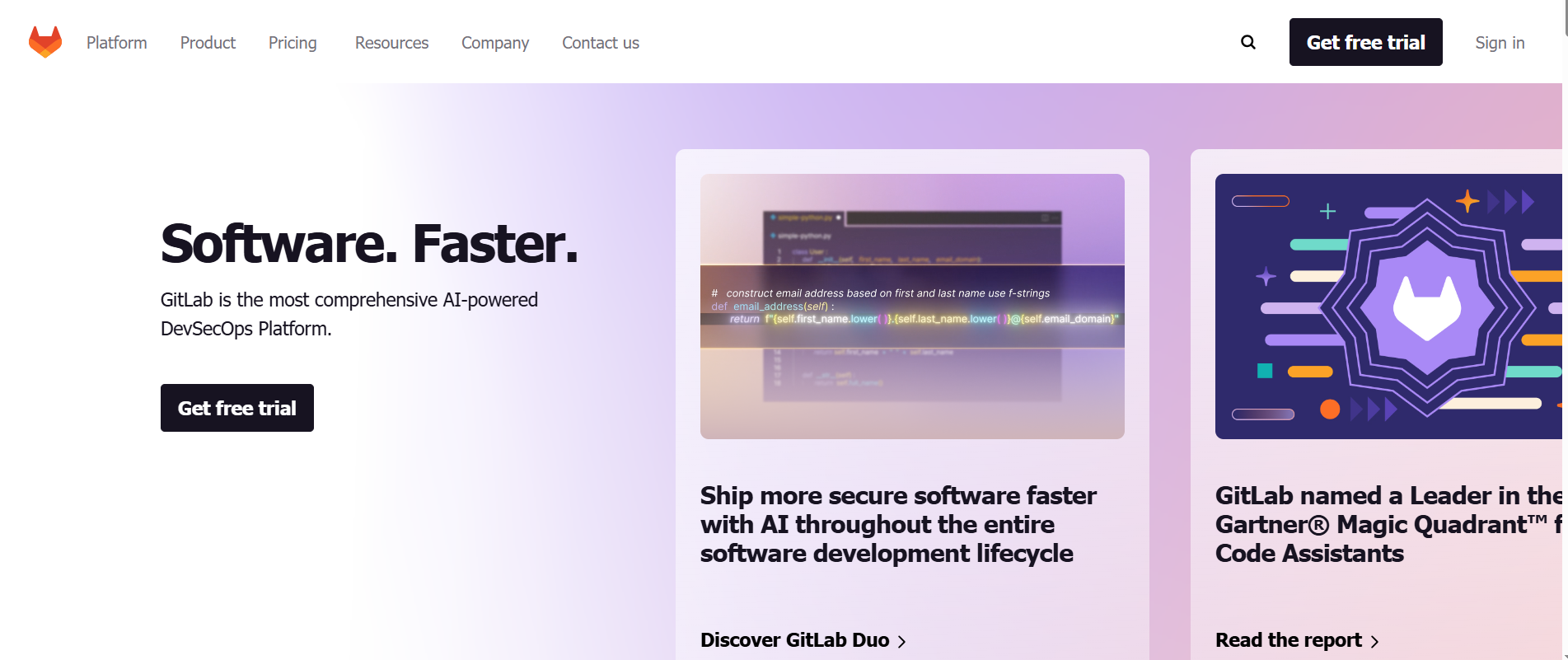 GitLab is an integrated DevOps Software that offers a comprehensive suite of tools for source code management (SCM), continuous integration/continuous delivery (CI/CD), and security monitoring. It enables teams to collaborate and automate the entire software development lifecycle.
GitLab is an integrated DevOps Software that offers a comprehensive suite of tools for source code management (SCM), continuous integration/continuous delivery (CI/CD), and security monitoring. It enables teams to collaborate and automate the entire software development lifecycle.
Features:
-
End-to-end DevOps platform: GitLab offers a single platform for managing the complete DevOps lifecycle, from planning to deployment and monitoring.
-
Built-in CI/CD: GitLab comes with integrated CI/CD features, making it easier to implement automated testing, building, and deployment pipelines.
-
Auto DevOps: Automatically configure CI/CD pipelines and deploy to Kubernetes clusters with minimal configuration.
-
Security features: GitLab offers built-in security scanning tools, including static and dynamic analysis, to identify vulnerabilities early in the development lifecycle.
Reviews:
GitLab is widely praised for its all-in-one nature, allowing teams to consolidate all DevOps activities into a single tool. Users appreciate the integrated approach, which simplifies workflows and reduces tool sprawl. However, some users note that GitLab’s free tier can be limiting, especially for larger teams.
Final Verdict:
GitLab is ideal for organizations looking for a comprehensive, integrated DevOps platform that covers all aspects of software development and operations. Its robust CI/CD and security features make it a powerful choice for DevOps teams.
Pros:
- Comprehensive DevOps platform with source control, CI/CD, and security
- Integrated tools reduce the need for external solutions
- Auto DevOps feature simplifies pipeline configuration
Cons:
- Free tier can be limiting for larger teams
- Some advanced features are gated behind premium plans
- Learning curve for users unfamiliar with the platform
#12. Bitbucket – Best for Git Repositories and CI/CD
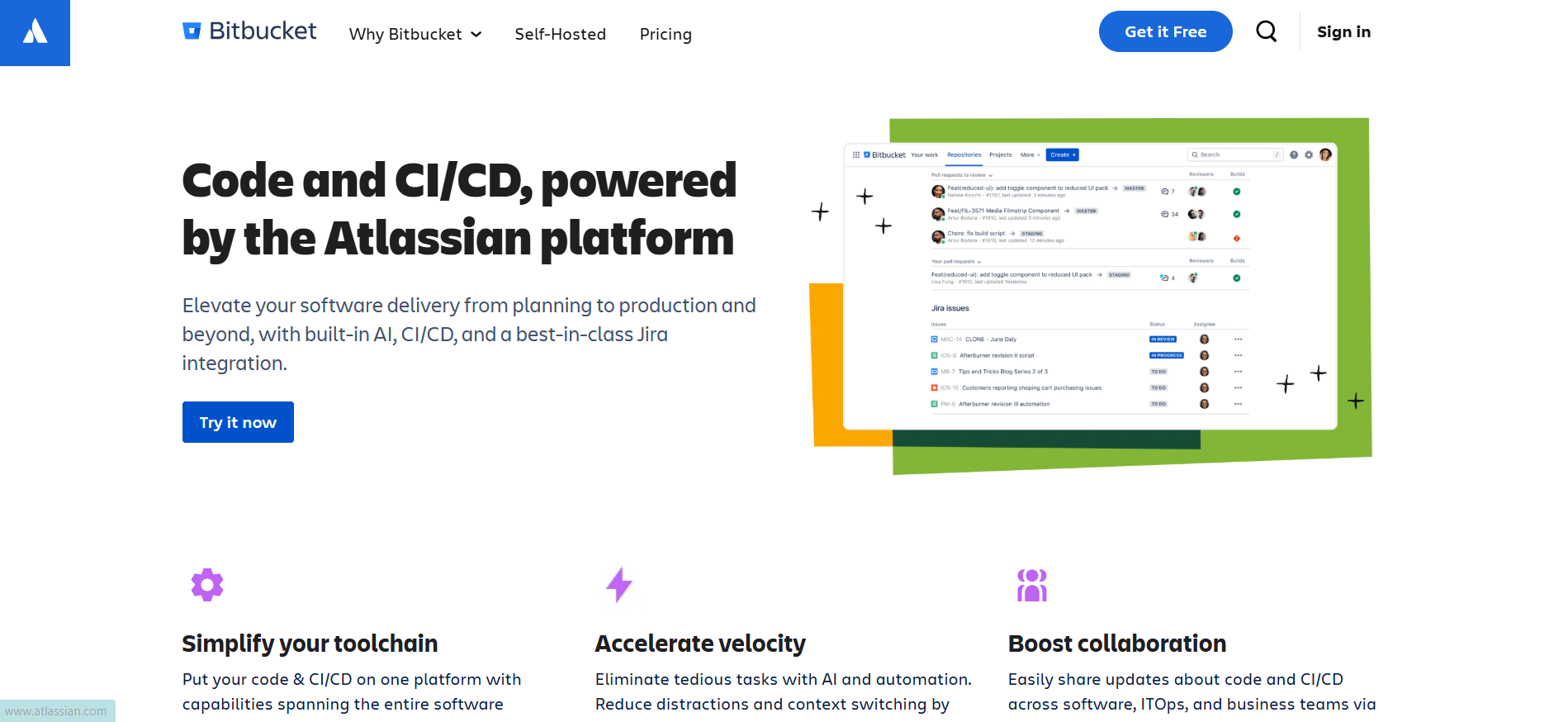 Bitbucket is a Git repository management DevOps Software developed by Atlassian. It integrates seamlessly with other Atlassian tools like Jira and Trello and provides native support for CI/CD pipelines through Bitbucket Pipelines.
Bitbucket is a Git repository management DevOps Software developed by Atlassian. It integrates seamlessly with other Atlassian tools like Jira and Trello and provides native support for CI/CD pipelines through Bitbucket Pipelines.
Features:
-
Git repository management: Bitbucket offers Git-based version control with support for private and public repositories.
-
Integrated CI/CD: Bitbucket Pipelines allows teams to build, test, and deploy applications automatically from within Bitbucket.
-
Strong integration with Jira: Bitbucket works seamlessly with Jira, enabling issue tracking and project management directly from the repository.
-
Branch permissions: Fine-grained access control to branches allows teams to manage permissions at the branch level for enhanced security.
Reviews:
Bitbucket is popular among teams that already use Atlassian products like Jira. Users appreciate its seamless integration and easy setup for CI/CD pipelines. However, some users report that Bitbucket Pipelines can become cumbersome for larger or more complex workflows.
Final Verdict:
Bitbucket is a great choice for teams using Atlassian products and seeking an integrated version control system with built-in CI/CD capabilities. Its integration with Jira enhances project management, making it a good fit for teams already using Atlassian tools.
Pros:
- Strong integration with Atlassian tools like Jira
- Built-in CI/CD through Bitbucket Pipelines
- Fine-grained access control for repositories
Cons:
- Pipelines can be cumbersome for complex workflows
- Limited third-party integrations compared to other tools like GitHub and GitLab
- Lacks some advanced features of other CI/CD platforms
#13. CircleCI – Best for Fast and Reliable CI/CD
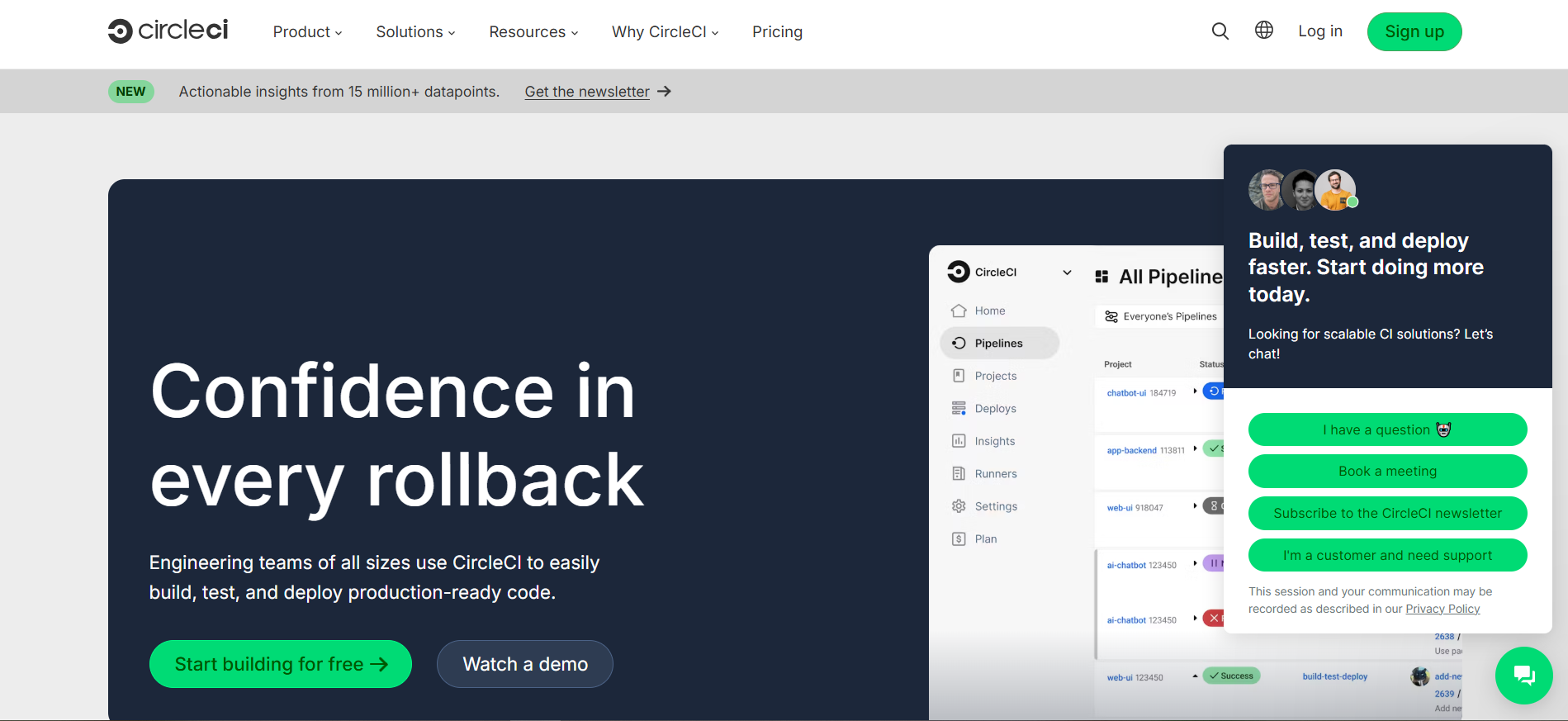 CircleCI is a cloud-based CI/CD platform known for its speed and reliability. It automates the software development lifecycle and enables teams to quickly test, build, and deploy applications.
CircleCI is a cloud-based CI/CD platform known for its speed and reliability. It automates the software development lifecycle and enables teams to quickly test, build, and deploy applications.
Features:
-
Fast build times: CircleCI is designed for speed, reducing the time it takes to test, build, and deploy applications.
-
Customizable pipelines: Users can define their workflows and configure their pipelines to suit their project needs.
-
Docker support: CircleCI works seamlessly with Docker, enabling teams to use containers in their CI/CD pipelines.
-
Scalability: CircleCI can scale with your team’s needs, supporting everything from small projects to large-scale enterprise applications.
Reviews:
CircleCI is praised for its reliability and speed in automating CI/CD processes. Teams appreciate the quick build times and robust support for Docker-based workflows. However, some users have found the setup process for more complex pipelines challenging.
Final Verdict:
CircleCI is ideal for teams looking for a fast, reliable CI/CD tool that scales with their needs. Its Docker support and ability to handle complex pipelines make it a top choice for teams with fast-paced development cycles.
Pros:
- Fast and reliable build times
- Excellent Docker support
- Highly scalable for teams of all sizes
Cons:
- Setup for complex workflows can be challenging
- Limited customization in certain areas
- May require a premium plan for advanced features
#14. Azure DevOps Server – Best for Enterprise-Level DevOps
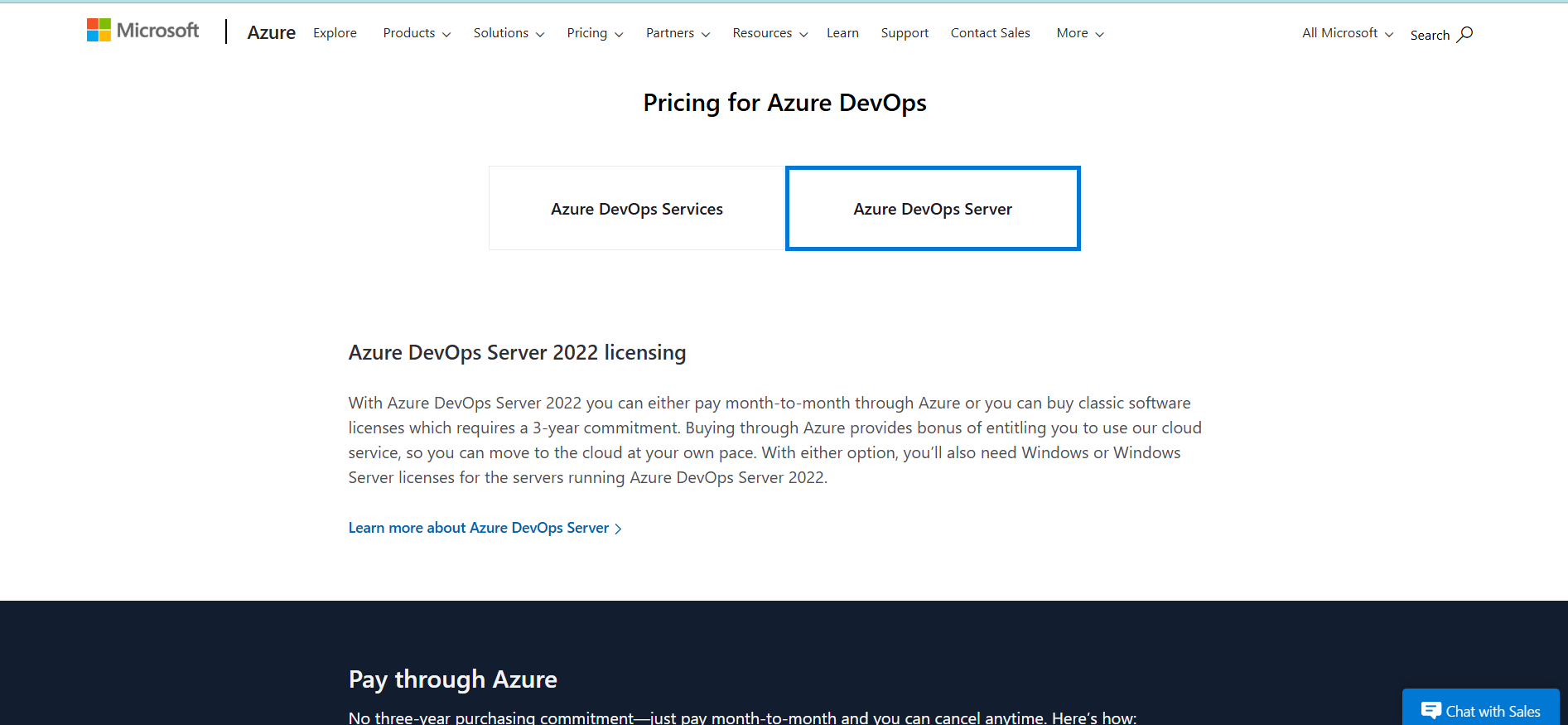 Azure DevOps Server (formerly known as Team Foundation Server) is a set of development DevOps Software from Microsoft designed to support teams working on enterprise-level applications. It provides integrated tools for planning, development, testing, and deployment.
Azure DevOps Server (formerly known as Team Foundation Server) is a set of development DevOps Software from Microsoft designed to support teams working on enterprise-level applications. It provides integrated tools for planning, development, testing, and deployment.
Features:
-
End-to-end DevOps lifecycle support: Azure DevOps Server provides tools for version control, automated testing, release management, and project tracking.
-
Integration with Microsoft products: It integrates seamlessly with Microsoft’s suite of products, including Visual Studio and Azure, offering a comprehensive ecosystem for enterprise applications.
-
Build and release automation: Automated build and release pipelines ensure that code is deployed quickly and consistently.
-
Collaborative project management: Integrated tools for agile project management help teams plan, track, and discuss work.
Reviews:
Azure DevOps Server is widely praised for its enterprise-grade capabilities, offering strong support for large teams and complex projects. However, users mention that the platform can be challenging to set up and is most beneficial for organizations already using Microsoft products.
Final Verdict:
Azure DevOps Server is ideal for large enterprises that require a comprehensive, integrated DevOps solution. It is best suited for teams already entrenched in the Microsoft ecosystem.
Pros:
- Comprehensive DevOps lifecycle tools
- Excellent integration with Microsoft products
- Great for large teams and enterprise-level projects
Cons:
- Complex setup and management
- Best suited for Microsoft-based environments
- Requires significant expertise to manage effectively
#15. Bamboo – Best for CI/CD and Release Management
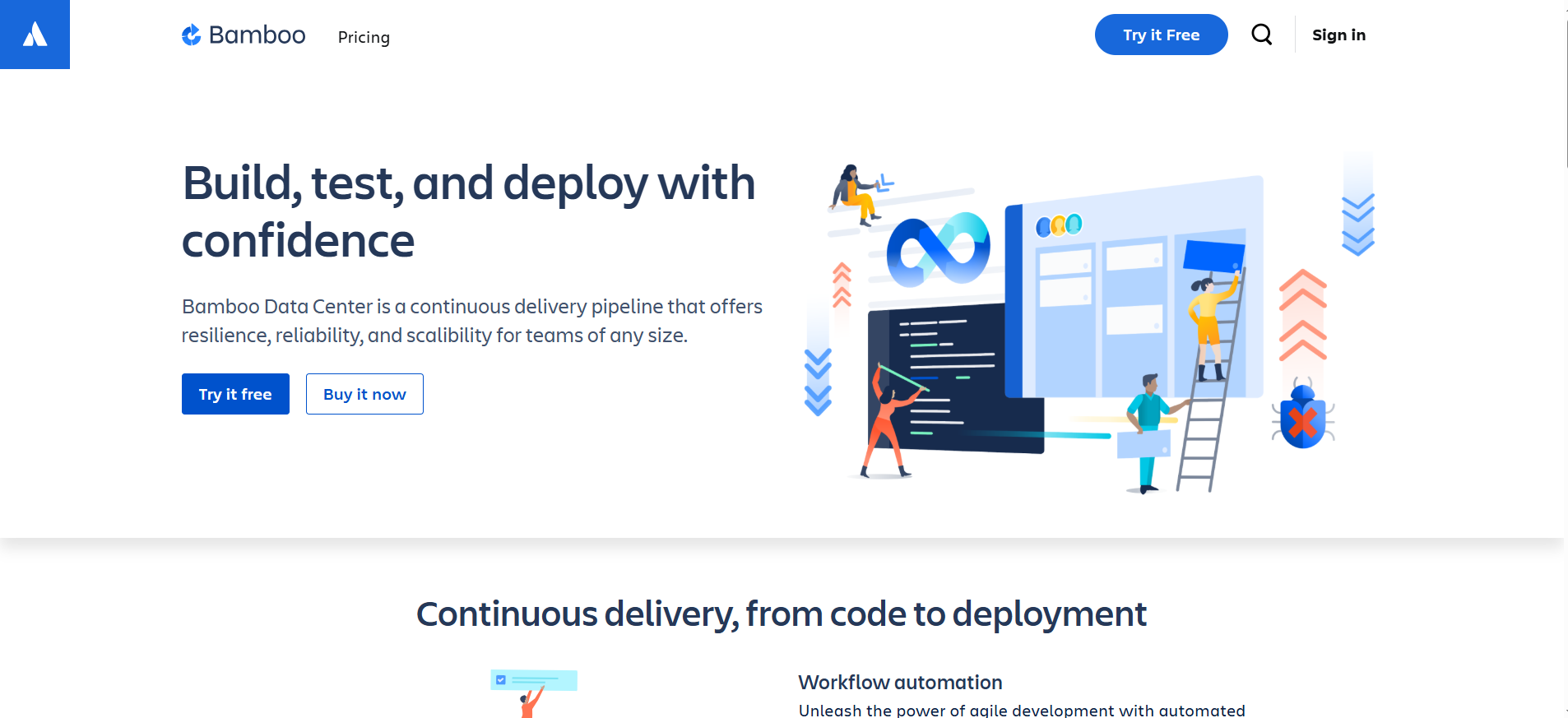 Bamboo by Atlassian is a CI/CD DevOps Software that integrates with other Atlassian products, offering automated build and release pipelines. Bamboo supports continuous integration, deployment, and testing for teams of all sizes.
Bamboo by Atlassian is a CI/CD DevOps Software that integrates with other Atlassian products, offering automated build and release pipelines. Bamboo supports continuous integration, deployment, and testing for teams of all sizes.
Features:
-
Built-in CI/CD pipelines: Bamboo provides built-in support for continuous integration and continuous delivery.
-
Integration with Jira and Bitbucket: Bamboo integrates with Jira for issue tracking and Bitbucket for source code management.
-
Customizable deployment projects: Teams can define custom deployment workflows, ensuring that applications are deployed quickly and reliably.
-
Scalability: Bamboo is suitable for teams of all sizes, from small startups to large enterprises.
Reviews:
Bamboo is well-loved for its integration with Atlassian products, making it an attractive choice for teams already using tools like Jira and Bitbucket. However, some users report that Bamboo’s setup can be complex, especially for teams new to CI/CD.
Final Verdict:
Bamboo is a solid choice for teams already using Atlassian products and seeking a streamlined CI/CD solution. Its integration with Jira and Bitbucket enhances collaboration, making it ideal for teams that rely on Atlassian tools.
Pros:
- Seamless integration with Atlassian products
- Customizable build and release pipelines
- Scalable for teams of all sizes
Cons:
- Complex setup and configuration
- Best suited for teams using Atlassian tools
- Pricing may be high for smaller teams
Conclusion
Choosing the right DevOps Software for your organization depends on your specific needs, team size, and infrastructure requirements. Whether you need continuous integration, container orchestration, IT automation, or monitoring, the tools listed above offer the best features for a variety of use cases.
For small teams or startups, tools like Jenkins, Docker, and GitHub Actions provide flexible, cost-effective solutions. Larger teams or enterprises can benefit from more scalable and feature-rich platforms like Kubernetes, Azure DevOps, and GitLab.
Consider the complexity of your workflows, your team’s expertise, and the size of your infrastructure when choosing the right DevOps Software. Each of the tools above excels in specific areas, and the right choice will depend on how you prioritize automation, scalability, and integration with your existing systems.
Frequently Asked Questions (FAQs)
1. Which DevOps tool is best for small teams?
Jenkins, Docker, and GitHub Actions are great choices for small teams because of their flexibility and ease of use. These tools are cost-effective and offer strong community support, making them ideal for startups.
2. What’s the best DevOps tool for large-scale container management?
Kubernetes is the go-to choice for managing containers at scale. It automates the deployment, scaling, and management of containerized applications, making it ideal for large, complex environments.
3. Is Ansible suitable for beginners?
Yes, Ansible is known for its simplicity, especially for beginners. It uses YAML for configuration management, which is easy to read and write. Its agentless setup also makes it easy to get started with IT automation.
4. Can I use multiple DevOps tools together?
Yes, many DevOps tools integrate seamlessly with each other. For example, Jenkins can be combined with Docker for continuous delivery, and Kubernetes can work alongside Prometheus for container orchestration and monitoring.
5. How do I choose the best DevOps tool for my company?
The best DevOps tool depends on your infrastructure, team size, and development processes. If you are working with containers, Docker and Kubernetes are great choices. For CI/CD pipelines, Jenkins and GitLab are excellent options, while Prometheus is ideal for monitoring large-scale systems. Choose a tool that aligns with your specific DevOps needs.
